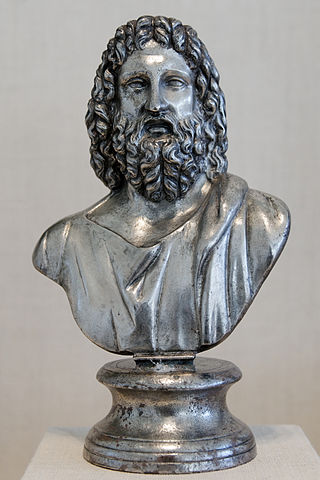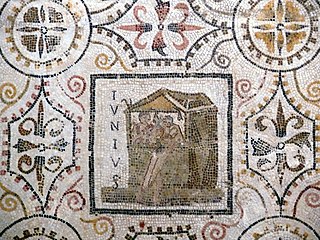
Isis was a major goddess in ancient Egyptian religion whose worship spread throughout the Greco-Roman world. Isis was first mentioned in the Old Kingdom as one of the main characters of the Osiris myth, in which she resurrects her slain brother and husband, the divine king Osiris, and produces and protects his heir, Horus. She was believed to help the dead enter the afterlife as she had helped Osiris, and she was considered the divine mother of the pharaoh, who was likened to Horus. Her maternal aid was invoked in healing spells to benefit ordinary people. Originally, she played a limited role in royal rituals and temple rites, although she was more prominent in funerary practices and magical texts. She was usually portrayed in art as a human woman wearing a throne-like hieroglyph on her head. During the New Kingdom, as she took on traits that originally belonged to Hathor, the preeminent goddess of earlier times, Isis was portrayed wearing Hathor's headdress: a sun disk between the horns of a cow.

The Ides of March is the day on the Roman calendar marked as the Idus, roughly the midpoint of a month, of Martius, corresponding to 15 March on the Gregorian calendar. It was marked by several major religious observances. In 44 BC, it became notorious as the date of the assassination of Julius Caesar, which made the Ides of March a turning point in Roman history.

Cybele is an Anatolian mother goddess; she may have a possible forerunner in the earliest neolithic at Çatalhöyük. She is Phrygia's only known goddess, and was probably its national deity. Greek colonists in Asia Minor adopted and adapted her Phrygian cult and spread it to mainland Greece and to the more distant western Greek colonies around the 6th century BC.

Caesarea, also Caesarea Maritima, Caesarea Palaestinae or Caesarea Stratonis, was an ancient and medieval port city on the coast of the Eastern Mediterranean, and later a small fishing village. It was the capital of Roman Judaea, Syria Palaestina and Palaestina Prima, successively, for a period of c.650 years, and a major intellectual hub of the Mediterranean, from the time of Herod I until the Muslim conquest of the Levant. Today, the site is part of the Caesarea National Park, on the western edge of the Sharon plain in Israel.

In Sabine and ancient Roman religion and myth, Luna is the divine embodiment of the Moon. She is often presented as the female complement of the Sun, Sol, conceived of as a god. Luna is also sometimes represented as an aspect of the Roman triple goddess, along with Diana and either Proserpina or Hecate. Luna is not always a distinct goddess, but sometimes rather an epithet that specializes a goddess, since both Diana and Juno are identified as moon goddesses.

The Hilaria were ancient Roman religious festivals celebrated on the March equinox to honor Cybele.
Polemius Silvius was the author of an annotated Julian calendar that attempted to integrate the traditional Roman festival cycle with the new Christian holy days. His calendar, also referred to as a laterculus or fasti, dates to around 448–449. He was active in southeastern Gaul.

The Navigium Isidis or Isidis Navigium was an annual ancient Roman religious festival in honor of the goddess Isis, held on March 5. The festival outlived Christian persecution by Theodosius (391) and Arcadius' persecution against the Roman religion (395).
The siege of Caesarea relates to the siege and conquest of Caesarea Maritima of the Byzantine Empire's Palaestina Prima province by the Sasanian Persians in 614 CE.
A menologium rusticum, also known by other names, was a publicly displayed month-by-month inscription of the Roman calendar with notes on the farming activities appropriate for each part of the year. Two versions were recovered in Rome during the Italian Renaissance, the Menologium Rusticum Colotianum and the Menologium Rusticum Vallense. The first is now held by the Naples Museum and the second has been lost. Both of the known examples of the style appear to copy a separate original, include a sundial for tracking the hours of the day, and prominently display astrological information for each month. The original was probably carved sometime during the 1st century. In addition to these pillar-style menologia, the name is also sometimes applied to fasti and other wall calendars that include similar agricultural details in their coverage of the year.

In the Roman Empire, the Pelusia was a religious festival held March 20 in honor of Isis and her child Harpocrates. It would have coincided with the second day of the Quinquatria, a five-day festival to Minerva. The holiday was not a part of the Roman calendar before the mid-1st century AD, but had been added by the time of Marcus Aurelius (161–180). It is preserved in the Calendar of Filocalus as an official holiday.

Martius or mensis Martius ("March") was the first month of the ancient Roman year until possibly as late as 153 BC. After that time, it was the third month, following Februarius (February) and preceding Aprilis (April). Martius was one of the few Roman months named for a deity, Mars, who was regarded as an ancestor of the Roman people through his sons Romulus and Remus.

Aprilis or mensis Aprilis (April) was the second month of the ancient Roman calendar, following Martius (March) and preceding Maius (May). On the oldest Roman calendar that had begun with March, Aprilis was the second of ten months in the year. April had 29 days on calendars of the Roman Republic, with a day added to the month during the reform in the mid-40s BC that produced the Julian calendar.

The Serapia or Sarapia was a Roman Imperial religious festival devoted to the Greco-Egyptian god Serapis. It is found as an official holiday on 25 April as late as the Calendar of Filocalus in 354 AD. In farmers' almanacs (menologia rustica) dating to the first half of the 1st century, the day was a sacrum or rite for Serapis along with Isis Pharia, "Isis of the Lighthouse (Pharos) of Alexandria".

In the Roman Empire, Rosalia or Rosaria was a festival of roses celebrated on various dates, primarily in May, but scattered through mid-July. The observance is sometimes called a rosatio ("rose-adornment") or the dies rosationis, "day of rose-adornment," and could be celebrated also with violets (violatio, an adorning with violets, also dies violae or dies violationis, "day of the violet[-adornment]"). As a commemoration of the dead, the rosatio developed from the custom of placing flowers at burial sites. It was among the extensive private religious practices by means of which the Romans cared for their dead, reflecting the value placed on tradition (mos maiorum, "the way of the ancestors"), family lineage, and memorials ranging from simple inscriptions to grand public works. Several dates on the Roman calendar were set aside as public holidays or memorial days devoted to the dead.

On the ancient Roman calendar, mensis Iunius or Iunius, also Junius (June), was the fourth month, following Maius (May). In the oldest calendar attributed by the Romans to Romulus, Iunius was the fourth month in a ten-month year that began with March (Martius, "Mars' month"). The month following June was thus called Quinctilis or Quintilis, the "fifth" month. Iunius had 29 days until a day was added during the Julian reform of the calendar in the mid-40s BC. The month that followed Iunius was renamed Iulius (July) in honour of Julius Caesar.

In the Roman Empire, the Lychnapsia was a festival of lamps on August 12, widely regarded by scholars as having been held in honor of Isis. It was thus one of several official Roman holidays and observances that publicly linked the cult of Isis with Imperial cult. It is thought to be a Roman adaptation of Egyptian religious ceremonies celebrating the birthday of Isis. By the 4th century, Isiac cult was thoroughly integrated into traditional Roman religious practice, but evidence that Isis was honored by the Lychnapsia is indirect, and lychnapsia is a general word in Greek for festive lamp-lighting. In the 5th century, lychnapsia could be synonymous with lychnikon as a Christian liturgical office.
November or mensis November was originally the ninth of ten months on the Roman calendar, following October and preceding December. It had 29 days. In the reform that resulted in a 12-month year, November became the eleventh month, but retained its name, as did the other months from September through December. A day was added to November during the Julian calendar reform in the mid-40s BC.

Abdashtart I was a king of the Phoenician city-state of Sidon who reigned from 365 BC to 352 BC following the death of his father, Baalshillem II.














